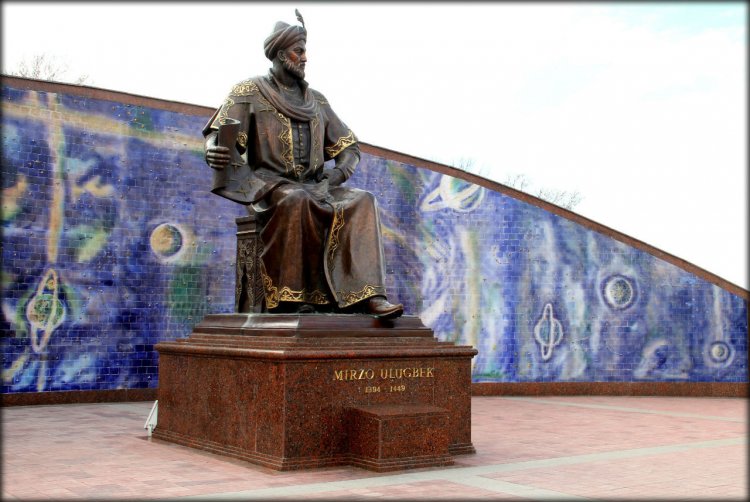Official:
Mirzo Ulugh Beg. March 22, 1394 – October 27, 1449. Central Asian ruler, Timurid sultan. He is known as an outstanding mathematician, astronomer, enlightener and poet.
Life and Work:
1. Yaroslav Golovanov claims that Ulugh Beg saw more cut-off heads than stars in the sky. Tamerlane’s grandson was born and spent his childhood in his grandfather’s military train, and he saw all sorts of things before becoming a great astronomer and discovering many stars.
2. Ulugh Beg was given the name Muhammad Taraghay at birth. He was born in the town of Soltaniyeh – now it is the territory of Iran. The future great Eastern scientist’s father was Timur’s youngest (seventeen-years-old at that time) son Shah Rukh. He named his son after his grandfather, the father of formidable Timur (Tamerlane).
3. The scientist’s full name was Muhammad Taraghay bin Shahrukh bin Timur Ulugh Beg Guragan. Ulugh Beg means “great or senior bey” in the Turkic languages. The title “Guragan” is an Iranized version of the Mongolian kurugen or khurgen, which means “son-in-law” or “khan’s groom.” Tamerlane was the first to take this title when he became related with the house of the Genghisids, i.e., the direct descendants of Genghis Khan.
4. To prevent parents from spoiling their children, they were taken from their parents in the Timurid time. Ulugh Beg was raised by Timur's elder wife Saray Mulk Khanum until the age of 11. Timur was closely following his grandchildren’s training and education. Sheikh Arif Azari, a poet and scientist, was assigned to Ulugh Beg for education and training.
5. The legend goes that the future great bey’s entire life was changed by the famous Nasir ad-Din al-Tusi observatory in Maragheh, near Tabriz, or, more precisely, what was left of it. He was carried away by astronomy for the rest of his life. He even built his famous observatory in Samarkand in the image and likeness of the Maragheh observatory.
6. Ulugh Beg began his career as a ruler at the age of 10, even before his grandfather’s death and his campaign in China: Timur's grandson became the ruler of Tashkent and Moghulistan, that is, Zhetysu and Eastern Turkestan. He got married for the first time at the same age.
7. After the death of Timur, the great commander’s descendants began to fight for his inheritance. In 1409, Ulugh Beg’s father took Samarkand and handed over the city and throne to his son. Two years later, Ulugh Beg became the ruler of Transoxiana, but he was little involved in politics, wars and intrigues. Ulugh Beg practically did not conduct any serious military operations in 1427-1447.
8. In 1428, Ulugh Beg carried out an important monetary reform, which had a beneficial effect on the economy of the state.
9. When Ulugh Beg became the ruler, he turned Samarkand into the center of world science – he built a madrasah and invited the best astronomers and mathematicians of the Islamic world.
10. By the standards of his time, Ulugh Beg was a very educated person: he knew languages, music and poetry. History has preserved information about his phenomenal memory: there is a recorded case when he almost unmistakably restored the lost list of his hunting trophies obtained throughout his life.
11. Ulugh Beg’s 30 years of scientific activities were crowned with the astronomical reference book Ziji Jadidi Guragani or New Guragan Astronomical Tables describing 1,018 stars. The book was quickly translated into Latin and kept in all observatories in Europe until the 17th century.
12. Ulugh Beg was carrying out his calculations of functions in sexagesimal fractions. When the value of the sine of one degree calculated by the scientist was converted into the decimal system, it turned out that he received the value accurate to the eighteenth decimal place. The length of the astronomical year calculated by Ulugh Beg turned out to be 365 days, 6 hours, 10 minutes and 8 seconds, that is, the error was less than a minute. According to Ulugh Beg, the inclination of the Earth's axis was 23.52 degrees, which was also quite accurate.
13. Ulugh Beg had to make a huge sextant to ensure the accuracy of his astronomical observations. To do this, he cut out some part of its arc in the rock. He took advantage of his position, and hundreds of stonecutters were cutting into the rock day and night.
14. In addition to astronomy, Ulugh Beg excelled in geography and history. He even created the historical work The History of Four Uluses.
15. However, the great bey did not master the science of winning in intrigues. His fascination with sciences irritated the courtiers and the military, so Ulugh Beg’s son Abdal-Latif did not have much difficulty in dethroning his father and taking over the throne.
16. At the same time, in October 1449, Ulugh Beg was treacherously killed by his son’s order. The deposed ruler performed the Hajj to Mecca, but he was stopped ostensibly to replenish supplies and executed by beheading. Ulugh Beg was buried in the Guri Amir mausoleum, next to his grandfather and father. In 1941, anthropologist M.M. Gerasimov opened the burial and restored the appearance of Ulugh Beg using his skull. Then the world learned about the scientist’s violent death.
17. Information about Ulugh Beg’s three wives survived: Genghis Khan’s descendant Aqi Sultan Khanika, Khalil Sultan’s daughter whose name is unknown, and Aka Begi Begum, daughter of Muhammad Sultan, Timur's grandson.
18. Some things owned by Ulugh Beg have survived to this day. However, to see them, one has to travel around the world. His personal chest is kept in the Topkapi Palace Museum in Istanbul. The ruby stone from Ulugh Beg’s crown was bought by Arab sheikh al-Sabah for his collection. Ulugh Beg’s jade cup is the crown jewel of the Calouste Gulbenkian Museum in Lisbon. Ulugh Beg’s jade bowl with the handle showing the lion biting the edge and the inscription “Karami Hakka nihoyat yukdur”, which means “God's bounty is endless,” is exhibited in the British Museum.
19. Ulugh Beg’s only lifetime portrait is a miniature created by an unknown court artist. It is a group portrait depicting Ulugh Beg’s Abdal-Latif and Abdal-Aziz, his wives, generals and servants. There is an inscription on the roof of the pavilion where Ulugh Beg: “The greatest sultan, Ulugh Beg Gurgan, blessing to his kingdom.”






















